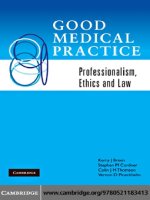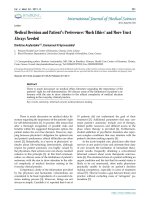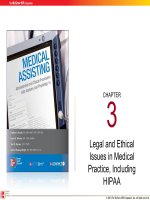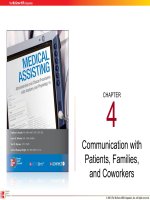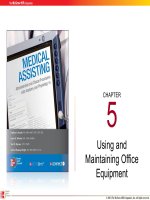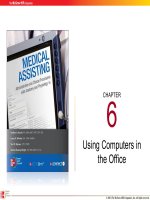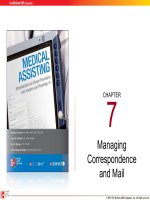Medical law and ethics 4e
Bạn đang xem bản rút gọn của tài liệu. Xem và tải ngay bản đầy đủ của tài liệu tại đây (5.69 MB, 405 trang )
FOURTH EDITION
Medical Law
and Ethics
BONNIE F. FREMGEN, Ph.D.
Pearson
Boston Columbus Indianapolis New York San Francisco
Upper Saddle River Amsterdam Cape Town Dubai London Madrid
Milan Munich Paris Montreal Toronto Delhi Mexico City Sao
Paulo Sydney Hong Kong Seoul Singapore Taipei Tokyo
Library of Congress Cataloging-in-Publication
Data
Notice: The material in this textbook contains the
most current information about the topic at the
time of publication. This text is not meant to be
Fremgen, Bonnie F.
used in lieu of qualified legal advice for
Medical law and ethics / Bonnie F. Fremgen. —
situations that arise in either one’s professional
4th ed.
practice or personal life. An attorney should
p. ; cm.
always be consulted for legal advice. Since laws
Includes bibliographical references and index.
for healthcare professionals vary from state to
ISBN-13: 978-0-13-255922-5
state, it is always wise to consult specific laws
ISBN-10: 0-13-255922-6
1. Medical laws and legislation—United States. within one’s state of practice.
2. Medical care—Law and legislation—United
States. 3. Medical ethics. I. Title.
Note Re Case Studies: The names used in the
[DNLM: 1. Legislation, Medical—United States.
2. Ethics, Medical—United States. W 32.5 AA1]
case studies throughout the text are fictitious.
KF3821.F74 2012
344.7304'1—dc22
2010044156
Publisher: Julie Levin Alexander
Publisher’s Assistant: Regina Bruno
Editor-in-Chief: Mark Cohen
Executive Editor: Joan Gill
Assistant Editor: Nicole Ragonese
Editorial Assistant: Mary Ellen Ruitenberg
Director of Marketing: David Gesell
Senior Marketing Manager: Katrin Beacom
Marketing Specialist: Michael Sirinides
Marketing Assistant: Crystal Gonzalez
Managing Production Editor: Patrick Walsh
Production Liaison: Julie Boddorf
Production Editor: Bruce Hobart, Laserwords
Senior Media Editor: Amy Peltier
Media Project Manager: Lorena Cerisano
Manufacturing Manager: Ilene Sanford
Manufacturing Buyer: Alan Fischer
Senior Art Director: Maria Guglielmo
Cover Designer: Wanda España at wee design
Cover Image: iStockphoto
Composition: Laserwords
Printing and Binding: R.R. Donnelley/Willard
Cover Printer: Phoenix Color Corporation
Credits and acknowledgments borrowed from other sources and reproduced, with permission, in this
textbook appear on the appropriate pages within text.
Copyright © 2012, 2009, 2006, 2002 by Pearson Education, Inc., Upper Saddle River, New Jersey,
07458. Pearson Prentice Hall. All rights reserved. Printed in the United States of America. This
publication is protected by Copyright and permission should be obtained from the publisher prior to
any prohibited reproduction, storage in a retrieval system, or transmission in any form or by any
means, electronic, mechanical, photocopying, recording, or likewise. For information regarding
permission(s), write to: Rights and Permissions Department.
Pearson Prentice Hall™ is a trademark of Pearson Education, Inc.
Pearson® is a registered trademark of Pearson plc
Prentice Hall® is a registered trademark of Pearson Education, Inc.
10
9
8
7
6
5
4
3
2
1
www.pearsonhighered.com
ISBN-13: 978-0-13-255922-5
ISBN-10:
0-13-255922-6
To my children, who have always been my inspiration for
ethical behavior. And a special thanks to my husband for his
continual support and help.
This page intentionally left blank
Brief Contents
1
PART I
Introduction to Medical Law, Ethics,
and Bioethics 1
THE LEGAL ENVIRONMENT
29
2
The Legal System
29
3
Importance of the Legal System for the Physician
and the Healthcare Professional 55
4
Today’s Healthcare Environment
PART II THE HEALTHCARE ENVIRONMENT
75
99
5
The Physician–Patient Relationship
6
Professional Liability and Medical
Malpractice 131
7
Public Duties of the Physician and the Healthcare
Professional 163
8
Workplace Law and Ethics
9
The Medical Record
10
185
217
Patient Confidentiality and HIPAA
PART III MEDICAL ETHICS
99
239
263
11
Ethical and Bioethical Issues in Medicine
12
Ethical Issues Relating to Life
13
Death and Dying
263
291
v
321
This page intentionally left blank
Contents
Preface xi
Letter to the Student xv
How to Interpret Case Citations xvii
About the Author xix
Reviewers xxi
1
Introduction to Medical Law, Ethics,
and Bioethics 1
Why Study Law, Ethics, and Bioethics? 3
Medical Law 7
Ethics 8
Models for Examining Ethical Dilemmas 18
What Ethics Is Not 20
Bioethics 21
The Role of Ethics Committees 22
Quality Assurance Programs 23
Medical Etiquette 23
PART I THE LEGAL ENVIRONMENT
29
2
The Legal System
The Legal System 31
Sources of Law 33
Classification of Laws 36
The Court Systems 44
The Trial Process 46
29
3
Importance of the Legal System for the Physician
and the Healthcare Professional 55
Medical Practice Acts 57
Licensure of the Physician 58
vii
viii
Contents
Standard of Care 61
Confidentiality 62
Statute of Limitations 63
Good Samaritan Laws 64
Respondeat Superior 64
Risk Management 67
4
Today’s Healthcare Environment
Today’s Healthcare Environment 77
Types of Medical Practice 82
The Ethics of Fee Splitting 86
Medical Specialty Boards 86
Allied Health Professionals 89
PART II THE HEALTHCARE ENVIRONMENT
5
6
75
99
The Physician–Patient Relationship
Physician’s Rights 101
Physician’s Responsibilities 102
Professional Practice Responsibilities 103
Patients’ Rights 112
Rights of Minors 119
Patients’ Responsibilities 119
Role of the Healthcare Consumer 124
Professional Liability and Medical
Malpractice 131
Professional Negligence and Medical Malpractice 134
The Tort of Negligence 135
Fraud 139
Office of Inspector General 141
Defense to Malpractice Suits 143
Professional Liability 145
Alternative Dispute Resolution 150
Liability of Other Health Professionals 151
99
Contents
Tort Reform 154
Malpractice Prevention 154
7
Public Duties of the Physician and the Healthcare
Professional 163
Public Health Records and Vital Statistics 165
Controlled Substances Act and Regulations 174
Protection for the Employee and the Environment 177
8
Workplace Law and Ethics 185
Professionalism in the Workplace 187
Discrimination in the Workplace 188
Privacy and the Workplace 188
Cultural Considerations 189
Religious Considerations 190
Effective Hiring Practices 191
Legal and Illegal Interview Questions 193
Federal Regulations Affecting the Medical Professional 194
Equal Employment Opportunity and Employment Discrimination 194
Employee Health and Safety 200
Compensation and Benefits Regulations 203
Consumer Protection and Collection Practices 206
9
The Medical Record 217
Purpose of the Medical Record 219
Contents of the Medical Record 220
Ownership of the Medical Record 226
Confidentiality and the Medical Record 226
Retention and Storage of Medical Records 229
Reporting and Disclosure Requirements 232
Use of the Medical Record in Court 233
10
Patient Confidentiality and HIPAA 239
Confidentiality 241
Health Insurance Portability and Accountability Act (HIPAA) of 1996 244
Ethical Concerns with Information Technology (Informatics) 256
ix
x
Contents
PART III MEDICAL ETHICS
263
11
Ethical and Bioethical Issues in Medicine
Early History 265
Ethical Standards and Behavior 266
Codes of Ethics 267
Codes of Ethics for Other Medical Professionals 269
Bioethical Issues 269
Ethical Issues and Personal Choice 274
The Ethics of Biomedical Research 275
Human Genome Project 278
Genetic Engineering 279
Healthcare Reform 282
12
Ethical Issues Relating to Life
Fetal Development 293
Assisted or Artificial Conception 294
Contraception 299
Sterilization 299
Abortion 302
Genetic Counseling and Testing 309
Wrongful-Life Suits 312
13
Death and Dying 321
The Dying Process 323
Legal Definition of Death 323
Stages of Dying 333
Quality-of-Life Issues 334
Use of Medications 334
Hospice Care 335
Palliative Care 336
Viatical Settlements 337
Advance Directives 337
Choices in Life and Death 338
Appendix A. Codes of Ethics
345
Appendix B. Case Citations
349
Glossary
Index
353
365
291
263
Preface
T
he allied health professional has always been an important member of the medical team. This team awareness is even more critical in today’s healthcare environment, because the physician no longer practices medicine alone. Therefore, the text
discusses medical law and ethics as it relates to allied healthcare professionals, as
well as the physician’s duties and responsibilities.
Medical Law and Ethics is written in straightforward language that is aimed at the
nonlawyer health professional who must be able to cope with multiple legal and ethical issues. This text is appropriate for those studying in a college or university who are
working toward careers in the allied health field in a variety of settings, such as medical offices, hospitals, clinics, laboratories, and skilled-nursing facilities. Because most
allied healthcare professionals work either with or for a physician, it is important to
understand the physician’s responsibilities and duties to the patient. Therefore, they are
covered in this book. Included are examples of common legal and ethical issues that
affect those working in the healthcare field. A wide range of pertinent topics are discussed, such as the legal system, professional liability and medical malpractice, public
duties of the physician, the medical record, and ethical and bioethical issues. There is
an in-depth discussion of the regulations affecting the healthcare professional, including up-to-date information about the Health Insurance Portability and Accountability
Act of 1996 (HIPAA). The intent is to help healthcare professionals to better understand
our ethical obligation to ourselves, our patients, and our employers. A new addition to
stimulate discussion is the Critical Thinking Exercise at the end of each chapter.
Many legal cases are sprinkled throughout the text to demonstrate the history of
the law as it pertains to subjects such as patient confidentiality, managed care, federal regulations affecting the employee, death and dying, and abortion. In some
examples, the cases may seem old, but because we as a country have a legal system
based on case law, these laws are still pertinent today. A legal icon (scales of justice)
appears in the margin to indicate legal case citations.
A special feature called Med Tips provides quick information about law and ethics.
These brief scenarios and hints help to maintain interest in this vital subject. Each chapter includes glossary terms highlighted in bold on first reference, extensive end-of-chapter
exercises, and one actual practice case. The appendices include a sample of codes of
ethics that form a basis for current practice and legal case citations.
This text provides an overview of medical law and ethics. Practicing health care
professionals should know the legal requirements in their own jurisdictions.
Finally, many educators have offered thoughtful comments as reviewers of this text.
I am extremely grateful that they have shared their time and experience to help
develop this textbook.
xi
xii
Preface
CHAPTER STRUCTURE
◗ Learning Objectives.
◗
◗
◗
◗
◗
◗
These include an overview of the basic knowledge discussed within the chapter and can be used as a chapter review.
Key Terms. Important vocabulary terms are listed alphabetically at the beginning of each chapter and printed in bold the first time they are defined in the text.
Introduction. Each chapter begins with an introductory statement that reflects
the topic of the chapter.
Review Challenge. A selection of short answer, matching, and multiplechoice questions are included to test the student’s knowledge of the chapter
material.
Case Study. The case studies are based on real-life occurrences and offer
practical application of information discussed within the chapter. These are
included to stimulate and draw upon the student’s critical-thinking skills and
problem-solving ability.
Critical Thinking Exercise. These exercises at the end of each chapter challenge the student to answer the question “What would you do if . . .” relating to
many current healthcare and legal dilemmas in today’s environment.
Bibliography. These useful resources provide further information on the topics
included within the chapter.
SPECIAL FEATURES
◗ Med Tip.
◗
◗
◗
◗
◗
Med Tips are placed at strategic points within the narrative to provide
helpful hints and useful information to stimulate the student’s interest in the topic.
Legal Case Citations. Discipline-specific cases are used throughout the text to
illustrate the topic under discussion. The cases reflect the many medical disciplines,
including that of the physician, that come together in the care of the patient. While
this book is not meant to be a law book, the cases cited in the book are meant to
emphasize the importance of the law for the students.
Points to Ponder. Thought-provoking questions give students an opportunity to
evaluate how they might answer some of the tough, medically related ethical
dilemmas in today’s society. These questions can also be used for critical debate
among students during a class activity.
Discussion Questions. These end-of-chapter questions encourage a review of
the chapter contents.
Put It into Practice. These thought-provoking activities appear at the end of
each chapter. They provide a clinical correlation with the topics discussed in the
chapter and stimulate the student’s own contemplation of legal and ethical issues
that are apparent in everyday life.
Web Hunt. This end-of-chapter internet activity encourages the student to access
the multitude of medical resources available through this medium.
Preface
◗ Appendices.
Codes of Ethics are included in Appendix A; useful healthcare
websites are listed online; the case citations used throughout the book are listed in
Appendix B.
◗ Additional Examination Review Questions. These are included in the
Instructor’s Resource Manual.
ACKNOWLEDGMENTS
This book would not have been possible without the assistance and guidance of
many people. I am grateful to the editorial and production staffs at Pearson Education
for their skill and patience with this project. I thank Joan Gill, executive editor and
Mark Cohen, editor-in-chief, for their leadership and guidance with this project;
Nicole Ragonese and Melissa Kerian whose courtesy and thoroughness are greatly
appreciated; Pat Walsh, managing production editor, whose calm presence is
always available; Julie Boddorf, production liaison; and Bruce Hobart, Laserwords,
whose skill and patience is remarkable, for their great attention to detail and all
their hard work.
xiii
This page intentionally left blank
Letter to the
Student
I
t’s a natural tendency to read some of the case examples in this book and think that
they must be fictional as no well-trained healthcare professional would ever be so
negligent. However, the short ethics cases at the beginning of each chapter, with the
exception of the historical cases, are indeed real. All of these cases are drawn from
the author’s experience.
Throughout the book there are numerous examples of actual legal cases that usually resulted in suffering for patients, as well as for physicians and other healthcare
professionals. The cases discussed are not meant to focus on particular healthcare
disciplines, nor to exclude any disciplines. And these cases are not meant to frighten
but, rather, to alert all of us to the potential risks to patients when healthcare professionals are not diligent about the care they provide. Do not memorize the case citations, but rather try to understand the circumstances and why the case was included
in this book.
I have a great respect for all the disciplines mentioned in this book. My intent is
to prepare students to promote good patient care, as well as to protect themselves
and their employers from lawsuits.
For a successful start to your study of medical law and ethics, consider following
the ABCs of classroom success: Actively participate, Benefit from the experience, and
Commit to learning. It is necessary for you to attend class to truly benefit from your
ethics education. So much happens in the classroom—especially the interaction
between you and your classmates. The discussion portion of an ethics class is one of
the most important components. You must be present to contribute. The text serves as
an information source and as the first step in your education—the dynamics of classroom interaction between you, your instructor, and the other students is critical for success in learning.
Actively participate when you attend class. It is necessary to absorb what takes
place during the class session. Listen carefully to what your instructor and fellow
students say. If you don’t share your ideas, experiences, and questions, then the
rest of the class is losing what you have to offer. The dialogue about ethics that you
have with your instructor and fellow classmates can be one of the most meaningful
learning experiences.
xv
xvi
Letter to the Student
Benefit from the experience and ideas of your peers (classmates). Listen to the
opinions of others during class discussions. Pay particular attention to the opinions
that differ from your own. As a member of the healthcare team, you will frequently
hear opinions that differ from your own—both from your coworkers and your
patients. You do not have to change your opinions or beliefs, but try to keep an
open mind to the opinions of others.
Commit to learning by carefully reading and analyzing the textbook material.
Look for new information and also for discussion points that both agree and disagree with your own perspective. Take this course seriously so that it is not a waste
of your time. In fact, your ethics class can be one of the most important classes that
you take! Communicate what you have learned. Your perspective is important for
others to hear. Use your time wisely in class, share your ideas, and listen to the
thoughts of others.
The law is dynamic and often is revised as changes take place in society. For
example, one of the newest laws affecting healthcare, the Healthcare Insurance
Portability and Accountability Act of 1996 (HIPAA), has recently had an added
impact regarding the necessity for healthcare organizations, including physicians’
offices, to provide notice to all patients concerning their privacy practices. This textbook is not meant to be a study of the law, but rather to introduce students to the
impact that law and ethics have on their professional lives.
Finally, our goal as teachers is to help our students learn how to judge themselves
and their actions. Because you won’t have us with you in the workplace, we want
you to be able to evaluate your own actions in light of their ethical and legal impact
on others.
How to Interpret
Case Citations
S
elected legal cases are used in this textbook to illustrate various legal principles.
At the end of each case summary is a citation such as, Moon Lake Convalescent
Center v. Margolis, 433 N.E.2d 956 (Ill. App. Ct. 1989). This citation, similar to a
street address, tells you where you can find this case among the many sets of
reported cases (called reporters) in the library. Most case citations end with information in parentheses, such as (Ill. App. Ct. 1989), which tells you what court (the
Illinois Appellate Court) decided the case and the year (1989) of the decision, but
you do not need that information when you are simply trying to locate a particular
case in the library. The small v. between the litigants’ names stands for “versus.” A
case citation consists of
◗ The italicized case name—usually the name of the plaintiff and the defendant. In
◗
◗
◗
◗
◗
our example, Moon Lake Convalescent Center (defendant) and Margolis (plaintiff).
The name of the reporter(s) where the case is published (Northeast Reporter, 2d series).
The volume number(s) of the reporter(s) where the case is published (433).
The page number of the volume where the case begins (956).
The year the case was decided (1989).
For federal Court of Appeals cases, a designation of the circuit; for federal District
Court cases, the state and judicial district where the court is located; for state
cases, an indication of the state if it is not apparent from the name of the reporter
(Illinois Appellate Court).
Therefore, our example case between Moon Lake Convalescent Center and
Margolis is found in volume 433 of the Northeast Reporter, 2d series, on page 956.
Abbreviations for other reporters (books) are:
A (Atlantic Reporter)
P (Pacific Reporter)
U.S. (United States Reporter)
F.Supp. (Federal Supplement)
F (Federal Reporter)
NE (Northeast Reporter)
NW (Northwest Reporter)
NYS (New York Supplement)
So (Southern Reporter)
SW (Southwestern Reporter)
xvii
xviii
How to Interpret Case Citations
Most reporters have been published in two or more series, such as 2d, meaning
second series. The student should not be concerned with memorizing the names of the
reporters. The abbreviations for them are found at the beginning of most of the legal
research publications that we use. As you do research within your own state, you will
become familiar with the abbreviations that are most commonly used. Legal research
can be done through a law library or via the Internet from Lexis-Nexis, which is a
subscription service used by law firms and libraries.
About the Author
B
onnie F. Fremgen, Ph.D., is a former associate dean of the Allied Health Program
at Robert Morris College and was vice-president of a hospital in suburban
Chicago. She has taught medical law and ethics courses as well as clinical and
administrative topics. She has broad interests and experiences in the healthcare field,
including hospitals, nursing homes, and physicians’ offices. She currently has a
patent pending on a unique atrophy-reducing wheelchair.
Dr. Fremgen holds a nursing degree as well as a master’s in healthcare administration. She received her Ph.D. from the College of Education at the University of
Illinois. She has performed postdoctoral studies in medical law at Loyola University
Law School in Chicago.
Dr. Fremgen has taught ethics at the University of Notre Dame, South Bend,
Indiana; University of Detroit, Detroit, Michigan; and Saint Xavier University,
Chicago, Illinois.
xix
This page intentionally left blank
Reviewers
FOURTH EDITION REVIEWERS
Rosana Darang, MD
Bay State College
Boston, Massachusetts
Michelle Lovings, MBA
Missouri College
Brentwood, Missouri
Amy DeVore, CPC, CMA (AAMA)
Butler County Community College
Butler, PA
Lorraine Papazian-Boyce, MS, CPC
Colorado Technical University Online
Hoffman Estates Illinois
Candace Lynn Doyle, M.S.Ed.
Midlands Technical College
West Columbia, South Carolina
Donna M. Rowan, MAT
Harford Community College
Bel Air, Maryland
Gail High, CMOA
YTI Career Institute - Altoona Campus
Altoona, Pennsylvania
George W. Strothmann, CPhT
Sanford Brown Institute
Fort Lauderdale, FL
Cecelia Jacob, MA
Southwest Tennessee Community College
Memphis, Tennessee
Lori Warren Woodard, MA, RN, CPC,
CPC-I, CCP, CLNC
Spencerian College
Louisville, Kentucky
Ana M. Linville, M.Ed. BAAS,
MT(AMT), MLT(ASCP)
University of Texas at Brownsville/Texas
Southmost College
Brownsville, Texas
Mindy Wray, BS, CMA, RMA
ECPI - Greensboro Campus
Greensboro, North Carolina
PREVIOUS EDITION REVIEWERS
Frank Ambriz, PA-C, MPAS
University of Texas–Pan Am
Edinburg, Texas
Deborah Bedford, AAS, CMA
North Seattle Community College
Seattle, Washington
Theresa Allyn, BS
Edmonds Community College
Lynnwood, Washington
Norma Bird, MEd, BS, CMA
Idaho State University College of
Technology
Pocatello, Idaho
Anne M. Arto
Pasco-Hernando Community College
Brooksville, Florida
xxi
xxii
Reviewers
Susan J. Burnham, RNC, CLNC, IBCLC
Renton Technical College
Renton, Washington
Christine Malone, BS
Everett Community College
Everett, Washington
Rafael Castilla, MD
Hohokus School of Business and
Medical Sciences
Ridgefield, New Jersey
Betsey Morthland, MS
Black Hawk College
Moline, Illinois
Kat Chappell, CMA, BS
Highline Community College
Des Moines, Washington
Michael W. Cook, MA, RRT
Mountain Empire Community College
Big Stone Gap, Virginia
Tonya Hallock
Concorde Career Institute
Garden Grove, California
Mack Henderson, PhD, MEd,
CPC, CCS-P
Durham Technical Community College
Durham, North Carolina
Janice C. Hess, MA
Metropolitan Community College
Elkhorn, Nebraska
Robert K. Johnson, JD
Ivy Tech Community College
Greenwood, Indiana
Jennifer Lame, BS, RHIT
Idaho State University
Pocatello, Idaho
Vivian C. Lilly, PhD, MBA, MS, BS, RN
North Harris College
Houston, Texas
Sharon Tompkins Luczu, RN, BA,
MA, MBA
Gateway Community College
Phoenix, Arizona
Lisa Nagle, CMA, BSEd
Augusta Technical College
Augusta, Georgia
Michael O’Sullivan, DPH
University of Massachusetts–Lowell
Lowell, Massachusetts
Helen W. Spain, BSEd, MSEd
Wake Technical Community College
Raleigh, North Carolina
Susan Stockmaster, MHS
Trident Technical College
Charleston, South Carolina
Lenette Thompson
Piedmont Technical College
Greenwood, South Carolina
Valeria Truitt, BS, MAEd
Office Administration
Craven Community College
New Bern, North Carolina
Lori Warren, MA, RN, CPC, CCP, CLNC
Spencerian College
Louisville, Kentucky
Amy L. Wilson, BS, RT(R), RDMS, RVT
University of Southern Indiana
Evansville, Indiana
Introduction to
Medical Law,
Ethics, and
Bioethics
1
Learning Objectives
1.
2.
3.
4.
5.
Define the glossary terms.
Describe the similarities and differences between laws and ethics.
Discuss the reasons for studying law, ethics, and bioethics.
Describe how to apply the three decision-making models discussed in this chapter.
Explain why ethics is not just about the sincerity of one’s beliefs, emotions, or
religious viewpoints.
Key Terms
Amoral
Applied ethics
Bioethicists
Bioethics
Comparable worth
Compassion
Cost/benefit analysis
Due process
Duty-based ethics
Empathy
Ethics
Fidelity
Indigent
Integrity
Justice-based ethics
Laws
Litigious
Medical ethics
Medical etiquette
Medical practice acts
Morality
Precedent
Principle of autonomy
Principle of beneficence
Principle of justice
Principle of nonmalfeasance
Quality assurance
Rights-based ethics
Sanctity of life
Sexual harassment
Sympathy
Tolerance
Utilitarianism
Virtue-based ethics
1
2
Chapter 1
Introduction to Medical Law, Ethics, and Bioethics
THE CASE OF JEANETTE M.
AND THE PHONE CALL
eanette, an 80-year-old widow, called her physician early one morning
complaining of shortness of breath. She spoke to the office receptionist who asked if she was having any other difficulty. Jeanette said no.
The receptionist said she would give the message to the doctor.
The doctor’s office was extremely busy that October day giving out flu
shots. The receptionist immediately became busy answering telephone
calls and admitting a long line of patients waiting for their annual flu shot.
The telephone message from Jeanette was left unnoticed on the front
office desk for several hours and was then placed on the physician’s desk
with other messages.
Jeanette became so exhausted from her shortness of breath that she
fell asleep. When she awoke in the afternoon she could not catch her
breath. She called her neighbor and just said, “Help.” Paramedics arrived at
Jeanette’s home shortly after the neighbor called 911 and found Jeanette
to be unresponsive. She was taken to the local emergency room where
she was diagnosed and treated for pneumonia and congestive heart failure. The emergency room staff tried to determine who her personal physician was, but Jeanette had no personal belongings or medical information
with her. She never regained consciousness and died that evening.
When her neighbor went over to Jeanette’s home that evening to feed
the cat, she noticed the light on the phone’s answering machine. The doctor had returned Jeanette’s call at 5:00 P.M. She apologized for not calling
sooner.
J
1. Do you believe that this case presents a legal or an ethical problem
or both?
2. In your opinion, is anyone at fault for Jeanette’s death?
3. Is anyone on the physician’s staff at fault? Is the physician at fault?
4. What could have been done to prevent this problem?
